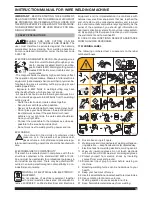
31
8.4
“JOB”
- “WORKING JOBS”.
If you wish to use a previously saved working program,
press key
T9
(JOB).
In order to see all the program settings, save the selection
with key
T9
(OK), then press key
T7
(PAR).
8.5
“H2O”
.
(see par. 7.3.1).
8.6
“WIZ”
WIZARD.
The
“wizard”
is a guided process that helps the operator
to make quick selections according to the desired weld-
ing process.
T5
T6
T7
T8
T9
To access, press key
T5
and then key
T9
(WIZ).
The first offered selection is the welding process.
The process selection is obtained by means of keys
T10
and
T11.
By pressing key
T9
(NEXT) you enter directly the material
selection page.
You may return to the previous page with key
T6
(PREV).
As an alternative to keys
T9
and
T6
you may use keys
T12
and T13
.
The next page is diameter page, then gas page, and then
again “Start Mode” page. Press “END” to finish
9 WELDING
• Prepare the welding machine by following the instruc
-
tions described under paragraph 3 “Start-up”.
• Follow the instructions previously described in menu
“Wizard”
Par. 8.1 or Par. 7.1.
9.1 MIG/MAG WELDING.
• Follow the instructions previously described in menu
“Wizard”
Par. 8.1 or Par. 7.1.
In menu
“Process Parameters”
the items that may be set
in this process are listed:
This welding machine offers a wide selection of MIG/
MAG welding processes that are listed below:
9.1.1 MIG
Synergic MIG/MAG welding.
The feature of this type of welding process is the SIN-
ERGY, meaning a Factory presetting of the relation be-
tween wire speed (current), voltage and impedance that
are required to obtain a good welding operation. To do so
proceed as follows:
• By means of key
T1
select the thickness led.
• Set the thickness being used by turning knob
M1
.
• Carry out the welding operation.
• If the arc length is not correct, modify it by means of
knob
M2
.
9.1.2 MIG Man. Traditional MIG/MAG welding.
Select wire type and diameter, and type of gas protection
device.
In this welding process wire speed, voltage and imped-
ance value mut be set by the operator.
9.1.3 MIG HD. Synergic MIG/MAG welding - high de-
posit.
The feature of this type of process is the possibility of in-
creasing the wire speed, the welding voltage being the
same, and this reduces weld execution time and distor-
tion, with higher productivity.
This is a synergic process but it differs from the other
processes as far as the setting mode is concerned: To
scroll along the synergic curve, use knob M2 which
changes the welding voltage and then with knob M1
you can modify the wire speed (welding current)
.
An example:
Select this process as previously described.
By means of key
T1
select led
L2
wire speed.
By means of key
T1
select led
L2
of wire speed and with
key
T2
the voltage led
L4
.
the display
D1
shows the wire speed while the display
D2
shows the voltage.
Rotate knob
M2
to modify voltage and wire speed values
by following the factory set synergic curve.
Rotate by one step knob
M1:
display
D3
will show
the page corresponding
to the wire speed cor-
rection.
If you continue rotating knob
M1
you will see the percent-
age deviation from zero which corresponds to the factory
preset speed, while display
D1
shows the new speed.
When the correction value causes the synergic curve to
reach the minimum or the maximum speed, display
D3
shows the message "
Speed limit
".
By correcting the wire speed, you do not modify neither
the thickness values that are recommended for the weld-
ing nor the current value, but it is possible to increase
the wire speed. The wire speed modification by means
of knob M1 does not change the previously set welding
voltage.
After a welding operation with led
L8
“Hold” ON, the dis-
play
D1
shows the welding current corresponding to the
modified wire speed.
9.1.4 MIG Root Synergic MIG/MAG welding.
This process is designed for “root” welding of descent
vertical “butt” welds. Suitable for iron and stainless steel.
9.1.5 MIG
Pulse synergic MIG/MAG welding
(upon request Art. 231).
In this welding process the filler material is transferred with
Summary of Contents for EVO SPEED STAR 380 TC
Page 87: ...87...
Page 139: ...139...
Page 180: ...180 5 5 BA 6 6 7 7 3 4 F 8 8 BN BN CA CA BN CA BN D G 3 5 A 1683 ANT 318 319 9...
Page 181: ...181 9 M 3 6 3 6 1 3 7 IEC CEI EN 60974 9 G E F M B A D Q R H N T V S U W V Fig 10 L...
Page 195: ...195 Art 318...
Page 196: ...196 Art 319...
Page 197: ...197 Art 319...
Page 198: ...198 Art 320...
Page 199: ...199 Art 320...
Page 201: ...201 Art 318...
Page 203: ...203 Art 319...
Page 205: ...205 Art 320...
Page 207: ...207 Art 319 320...
Page 211: ...211...
















































